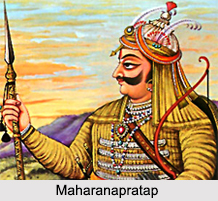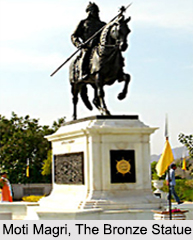 Maharana Pratap Singh is believed to be the epitome of fiery Rajput pride and self-respect; he has exemplified the qualities to which Rajputs aspired for centuries. Maharana Pratap Singh was born as the eldest child among 25 brothers and 20 sisters at Kumbhalgarh on May 9, 1540 to Maharana Udai Singh II and Maharani Javanta Bai Songara (Chauhan). The birthplace of Maharana Pratap Singh is known as Juni Kacheri.
Maharana Pratap Singh is believed to be the epitome of fiery Rajput pride and self-respect; he has exemplified the qualities to which Rajputs aspired for centuries. Maharana Pratap Singh was born as the eldest child among 25 brothers and 20 sisters at Kumbhalgarh on May 9, 1540 to Maharana Udai Singh II and Maharani Javanta Bai Songara (Chauhan). The birthplace of Maharana Pratap Singh is known as Juni Kacheri.
Maharana Pratap and the Mughals
In 1568, during the reign of Udai Singh II, the Mughal emperor Akbar conquered Chittor. The third Jauhar of Chittor became apparent, with the ladies of the fort finding safety from personal dishonour and plunged themselves into fire, while rest of the men folk sallied forth to certain death in the battlefield. Before this condition, Udai Singh and his family had moved to the safety of the nearby hills. He later moved his base to another location in the foothills of the Aravalli mountain Ranges. This new foundation gradually became the city of Udaipur and was accordingly named after him. Udai Singh wished Jagmal, his favourite son could succeed him but his senior nobles wanted Pratap, the eldest son, to be their king. During the coronation ceremony Jagmal was actually moved out of the palace and Pratap was deliberately made the king. Pratap did not want to go against the desire of his father but Rajput nobles convinced him strongly that Jagmal was not capable to rule in the crucial times of the day. It was the beginning of a career of struggle and hardship for Maharana Pratap Singh.
Maharana Pratap Singh never believed Akbar as the ruler of India, and kept on fighting with Akbar all his life. Akbar first tried several diplomatic ways to win over Maharana Pratap but nothing really worked. Maharana Pratap Singh maintained that he had no intention to fight with Akbar, however he could not bow down to Akbar and accept him as the ruler. Some historians argue that there was some possibility that Maharana Pratap Singh could have become friends with Akbar, but in the invasion for Chittor, Akbar had killed around 30,000 civilians, unarmed residents of Chittor only because they refused to convert to Islam. This left an ever-lasting impression on Maharana Pratap Singh`s mind and he became adamant not to bow to such an injustice and cruelty. He strictly followed the Hindu warrior code to refrain from attacking a non-combatant or a person who has laid down his weapons.
Tod`s Annals and Antiquities of Rajasthan declare that Maharana Pratap Singh stopped the marriage etiquette of Rajputs who had been giving their daughters to Mughals and his supporting Rajputs. Since Chittorgarh or Maharana Pratap Singh`s ancestral home, was under Mughal occupation, he lived a life with the dream of re conquering Chittor and thus reclaiming the glory of Mewar. His future efforts were bent towards this goal
Maharana Pratap and the Battle of Haldighati
On June 21, 1576 (June 18 by other calculations), the two armies met at Haldighati Mountain, near the town of Gogunda. The Mughal forces greatly outnumbered Maharana Pratap Singh`s men. The battle of Haldighati happen to be a historic event in the history of Rajasthan, lasted only four hours. In this short period, Maharana Pratap Singh`s men essayed many brave exploits on the field. Maharana Pratap Singh personally attacked Man Singh, his horse Chetak placed its front feet on the trunk of Man Singh`s elephant and Maharana Pratap Singh threw his lance; Man Singh ducked, and the mahout also died. Riding his trusty steed Chetak, Maharana Pratap Singh made good escape to the hills. Chetak was severely wounded in this war and died leaving behind Maharana Pratap Singh in deep grief. A mausoleum to Chetak is at the site of the steed`s death.
 The battle of Haldighati is considered to be a major breakthrough of Rajputs against the Mughals since the Second Battle of Khanwa in 1527 that was fought between Rana Sanga grandfather of Maharana Pratap Singh and the Mughal Emperor Babur, grandfather of Akbar. Many Rajput families regard it with a degree of significance.
The battle of Haldighati is considered to be a major breakthrough of Rajputs against the Mughals since the Second Battle of Khanwa in 1527 that was fought between Rana Sanga grandfather of Maharana Pratap Singh and the Mughal Emperor Babur, grandfather of Akbar. Many Rajput families regard it with a degree of significance.
Maharana Pratap Singh started living in the hilly wilderness of the Aravallis and continued his struggle. His one attempt at open confrontation having thus failed, Maharana Pratap Singh decided to take up the tactics of guerilla warfare. Using the hills as his base, Maharana Pratap Singh harassed the large and therefore awkward Mughal forces in their encampments. Akbar dispatched three more expeditions to hunt for Maharana Pratap Singh`s troops out of his mountainous hideouts, but they all failed. During this era, Maharana Pratap Singh received handsome financial assistance from Bhamashah, a well wisher.
Maharana Pratap and the Bhil Tribe
The Bhil tribe of the Aravalli hills provided Maharana Pratap Singh with their support during times of dangerous war and their expertise in living off the forests during times of peace. Later, Maharana Pratap Singh started to live in Chavand in the mountainous south eastern area of Mewar. The Mughals however did not stop harassing them and the exiles were continued in those ravines for many years by subsisted on wild berries and by hunting and fishing. Akbar kept sending expeditions against Maharana Pratap Singh, but never succeeded. He exhausted a lot of money and men in trying to defeat Maharana Pratap Singh but for almost 30 years Maharana Pratap Singh remained ahead of Akbar and in the last ten years of his life was able to release most of his kingdom. The only fort Maharana Pratap Singh could not recover was Chittor and that kept him disappointed throughout. However, his son Amar Singh managed to win that fort after Maharana Pratap Singh`s death. Maharana Pratap Singh had 17 sons and five daughters. The male-line descendants of Udai Singh II carry the patronymic title of "Ranawat".
Death of Maharana Pratap
Maharana Pratap died of severe injuries sustained in a hunting accident. Legends say that, when he was dying, Maharana Pratap Singh made his son and successor and asked Amar Singh to swear to maintain eternal conflict against the Mughals. Thus, his stressed circumstances did not overpower Maharana Pratap Singh even during his declining years; he remained brave to the end. Maharana Pratap Singh also did not sleep on a bed because of a vow that until Chittor was freed he would sleep on the floor and live in a hut despite the fact that he had retrieved back almost his entire kingdom from Akbar. On January 29, 1597, Maharana Pratap Singh died at Chavand, when he was aged fifty-six.
A remarkable bronze statue of Maharana Pratap Singh and his favourite and loyal horse, who was highly protective of his master and stood by him till his last breath, stands at the top of Moti Magri or the Pearl Mount overlooking Fateh Sagar in Udaipur. Local people climb the hill to pay homage to the great Maharana Pratap Singh and his faithful charger `Chetak`. There are the ruins of one of the first self-effacing palaces of Udaipur and a charming Japanese rock garden close by.
Maharana Pratap is a great hero in the eyes of Indians - respected and loved by his people. Maharana Pratap Singh alone stood firmly for his honor and dignity and never compromised with his rights. The memorable ruler died as a proud and free man.






